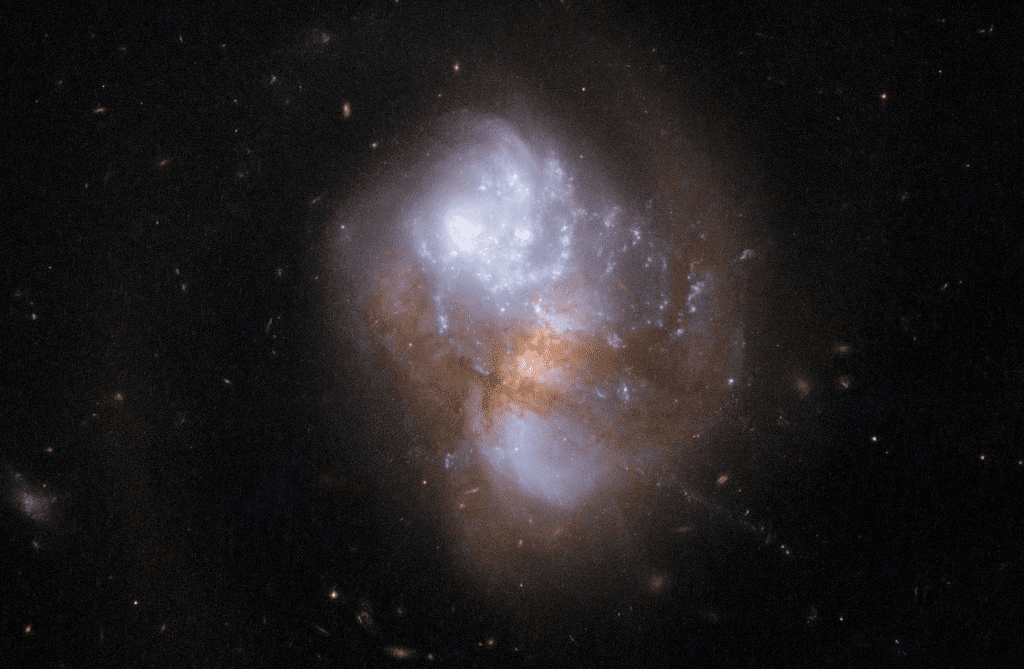When galaxies merge, the gravitational fields can stir gases, dramatically accelerating star formation. The end result is known as a starburst galaxy, and the JWST has turned its powerful eye to one of the most impressive examples, IC 1623, also known as VV 114.
Lying 270 million light-years from Earth in the constellation Cetus the Whale, IC 1623 has been a favorite of powerful telescopes for a while. Hubble has taken famous images of the galactic pair, but JWST has once again revealed its capacity to take things to another level.
The JWST’s image outshines Hubble’s not only because of its larger mirror, but because it sees so much further into the infrared. The lower galaxy in the above image, known as IC 1623B, is largely hidden at optical wavelengths by clouds of dust. Infrared radiation is less likely than optical light to be blocked by dust, which is one of the reasons the JWST was chosen to operate at those wavelengths. As can be seen in the Hubble image, IC 1623A is bright at optical and ultraviolet wavelengths, a product of many bright star clusters.

Hubble’s version of IC 1623 also shows one bright galaxy, but the other is shrouded by dust. Image credit: NASA, ESA. The Hubble Heritage (STScl/AURA)-ESA/Hubble Collaboration and A. Evans (University of Virginia, Charlottesville/NRAO/Stony Brook University)
The two component galaxies’ cores are currently separated by about 25,000 light years. The contrast between the colors at which they are bright is considered the most extreme of merging galaxies in the local universe.
IC 1623B is known to be rich in warm and dense gas, which is also abundant in the overlapping area between the merging galaxies, creating plenty of raw material for star formation.

Comparison of IC1623 as seen by the Hubble and two instruments on the JWST. Left: Optical Hubble/WFC3 & ACS. Middle: Near-infrared Webb/NIRCam. Right: Mid-infrared Webb/MIRI. In the MIRI image, only the bright core, heated gas and bubbles of star formation are visible. Image credit: ESA/Webb, NASA & CSA, L. Armus & A. Evans
The pair are estimated to be producing new stars at a rate twenty times greater than that of the Milky Way. The image is explored in a new study in which 40 star-forming regions are reported, a quarter of which have not been seen in optical observations. All but one of these newly identified regions lie in the overlap zone between the two galaxies.
Starburst galaxies are also rich in supernovas, since stars massive enough to end their lives in these explosions don’t live long, by astronomical standards. In 2011 IC 1623B had the rare distinction of having two supernovas within it in a single year.
Most galaxies, particularly of this size, have supermassive black holes at their core. Their mergers can bring these together to make an even larger black hole. This is likely to occur within IC 1623, but the dust has prevented Hubble and giant Earth-based telescopes from learning what stage this is at. Images like the one above could help resolve that question.
The visibility of the diffraction spikes, caused by the arms holding the JWST’s secondary mirror in place, are testimony to the brightness of the galaxies’ cores.
A paper on this image is accepted for publication in The Astrophysical Journal and is available on arXiv.
Source Link: JWST Views Galaxy Collision Causing Spectacular Burst Of Star Formation